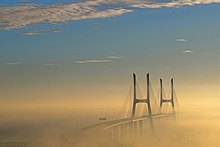Vasco da Gama Bridge
| Vasco da Gama Bridge | |
|---|---|

"Merging in the Mist"
|
|
| Coordinates | 38°45′32″N 9°02′19″W / 38.7589°N 9.0387°WCoordinates: 38°45′32″N 9°02′19″W / 38.7589°N 9.0387°W |
| Carries | Six road lanes of IP 1 |
| Crosses | Tagus River |
| Locale |
Sacavém, north of Lisbon (right/north bank) Alcochete and Montijo (left/south bank) |
| Official name | Ponte Vasco da Gama |
| Owner | Portuguese Republic |
| Maintained by | Lusoponte (1994–2030) |
| Characteristics | |
| Design | cable-stayed, viaducts |
| Total length | 12.345 kilometres (7.671 mi) |
| Width | 30 metres (98 ft) |
| Height | 155 metres (509 ft) (pylon) |
| Longest span | 420 m (1,378 ft) |
| History | |
| Designer | Armando Rito |
| Construction begin | February 1995 |
| Construction end | March 1998 |
| Opened | 29 March 1998 |
| Statistics | |
| Toll | Northbound: €2.70–€11.70 Southbound: toll free |
The Vasco da Gama Bridge (Portuguese: Ponte Vasco da Gama; pronounced: [ˈpõt(ɨ) ˈvaʃku dɐ ˈɡɐmɐ]) is a cable-stayed bridge flanked by viaducts and rangeviews that spans the Tagus River in Parque das Nações in Lisbon, the capital of Portugal.
It is the longest bridge in Europe (including viaducts), with a total length of 12.3 kilometres (7.6 mi), including 0.8 kilometres (0.50 mi) for the main bridge and 11.5 kilometres (7.1 mi) in viaducts. The Bridge is served by 4.8 kilometres (3.0 mi) of dedicated access roads. It was built with the purpose of alleviating the congestion on Lisbon's other bridge (25 de Abril Bridge) and preventing that traffic travelling between the North and South of the country had to pass through the city of Lisbon.
Construction began on February 1995; the bridge was opened to traffic on 29 March 1998, just in time for Expo 98, the World's Fair that celebrated the 500th anniversary of the discovery by Vasco da Gama of the sea route from Europe to India.
The bridge carries six road lanes, with a speed limit of 120 km/h (75 mph), the same as that on motorways, except on one section which is limited to 100 km/h (60 mph). On windy, rainy, and foggy days, the speed limit is reduced to 90 km/h (56 mph). The number of road lanes will be enlarged to eight when traffic reaches a daily average of 52,000.
The $1.1 billion project was split in four parts, each built by a different company, and supervised by an independent consortium. There were up to 3,300 workers simultaneously on the project, which took 18 months of preparation and 18 months of construction. The financing is via a build-operate-transfer system by Lusoponte, a private consortium which receive the first 40 years of tolls of both Lisbon bridges. Lusoponte's capital is 50.4% from Portuguese companies, 24.8% French and 24.8% British.
...
Wikipedia

